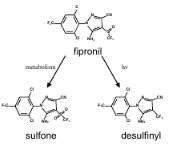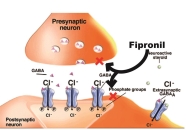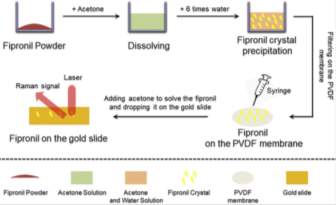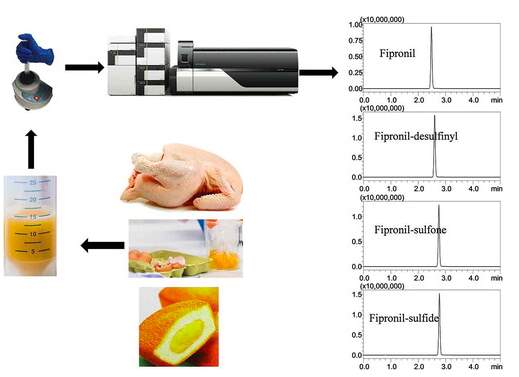Fipronil Contamination Prevention
Info: 2639 words (11 pages) Dissertation
Published: 9th Dec 2019
FOODBORNE OUTBREAK: FIPRONIL
Fipronil (5 – amino -1- [ 2, 6 – dichloro- 4 (trifluoromethyl) phenyl] 4 [(trifluoromethyl) sulfinyl] 1H- pyrazole – 3 – carbonitrile) is considered a new generation insecticide that belongs to the phenylpyrazole chemical class. It was discovered and developed by the pharmaceutical Rhône-Poulen between 1985 and 1987 and finally, it was launched into the market into 1993 (Van Scoy and Tjeerdema, 2014) .
It is a white powder with low-moderate solubility in water (1.9 mg/L at pH 5 and 2.4 mg/L at pH 9 both at 20ºC) and stable at room temperature (Van Scoy and Tjeerdema, 2014). It could be formulated in different ways such as a liquid spray, solid or also such as a granular product (C.Gupta, 2014). This insecticide degrades slowly with sunlight, and it is vulnerable to hydrolysis under alkaline conditions. It is also degraded by oxidation, hydrolysis, reduction and photolysis leading to other products (Van Scoy and Tjeerdema, 2014).
 Fipronil has two main metabolites: sulfone and desulfinyl fipronil (figure 1). Fipronil sulfone is formed rapidly in humans and animals and can remain much longer than Fipronil. The toxicity of desulfinyl is similar to Fipronil’s in quantitative terms. However, this metabolite presents a dose-effect curve for neurological effects more pronounced than Fipronil (NPIC, 2009).
Fipronil has two main metabolites: sulfone and desulfinyl fipronil (figure 1). Fipronil sulfone is formed rapidly in humans and animals and can remain much longer than Fipronil. The toxicity of desulfinyl is similar to Fipronil’s in quantitative terms. However, this metabolite presents a dose-effect curve for neurological effects more pronounced than Fipronil (NPIC, 2009).
Fig 1. Fipronil’s main metabolites
Fipronil is considered to have a broad-spectrum activity and it is generally used to battle insect pests such as: ants, beetles, fleas, ticks, termites, beetles, red mites, etc. It is also used in domestic animals such as dogs and cats (NPIC, 200). In fact, fipronil is the main ingredient of Frontline, considered as the most trendy ectoparasite veterinary product. Frontline is used to kill fleas and ticks that can cause Lyme disease in these animals. Another typical use of this insecticide is in agriculture, in order to treat the soil, seed coating and to protect the crop (C.Gupta, 2014). In Europe, its commercialization is permitted but it is totally forbidden to use it in animals that are involved in products for human consumption.
Fipronil’s mechanism of action is different from other insecticides such as organophosphates and carbamates. It acts in the central nervous system (CNS), thereby blocking the neurotransmitter GABA receptors by the union to the GABAa-gated chloride  channels (figure 2). GABAis the main neurotransmitter with inhibitory activity on the CNS. So, this blockade prevents the binding of GABA to its receptors thus, restricting the uptake of chlorine ions leading to hyperexcitation at low doses and paralysis and death at higher doses (Robea et al., 2018). Fipronil shows exceptional selectivity for GABA receptors on insects compared to mammals, which increases the margin of safety in humans and animals. However, a study has shown that its main metabolite, fipronil sulfone, is more active at mammalian chloride channels than those of insects (C.Gupta, 2014).
channels (figure 2). GABAis the main neurotransmitter with inhibitory activity on the CNS. So, this blockade prevents the binding of GABA to its receptors thus, restricting the uptake of chlorine ions leading to hyperexcitation at low doses and paralysis and death at higher doses (Robea et al., 2018). Fipronil shows exceptional selectivity for GABA receptors on insects compared to mammals, which increases the margin of safety in humans and animals. However, a study has shown that its main metabolite, fipronil sulfone, is more active at mammalian chloride channels than those of insects (C.Gupta, 2014).
Fig 2. Fipronil’s mechanism of action
Furthermore, this insecticide has shown to be toxic by ingestion, inhalation and by contact with the skin in animal experiments. For that reason, it has been established the LD50, a general measure of acute toxicity that means “lethal dose that produce death in 50 percent of the treated animals”. By ingestion, Fipronil is considered moderately toxic with an oral LD50 of 97 mg/kg in rats and 95 mg/kg in mice. By contact with the skin, it presents low to moderate toxicity with a LD50 of more than 2000 mg/kg in rat and 354 mg/kg in rabbits. Finally, by inhalation it also presents low to moderate toxicity with a 4-hour LD50 that varies between 0.390 to 0.682 mg/L in rats (NPIC, 2009).
The European Union (Regulation (EC) No. 396/2005) has established the MRL for this insecticide, which means the “maximum residue level” that can be found in food after it has been treated with the pesticide. The MRL for Fipronil can’t exceed 0.005 mg/kg, which is the sum of fipronil and sulfone fipronil (EU Pesticides database, 2016).
Fipronil has been classified by the World Health Organization (WHO), as “moderately toxic pesticide to people if it is eaten in large quantities, and can have dangerous effects on the kidneys, liver and thyroid glands”. Moreover, it is considered by the United States Environmental Protection Agency (USEPA) as “possible human carcinogen, group C” (NPIC, 2009). Depending on the intoxication route, it can cause different symptoms in humans. If there is contact with the eyes, it can cause eye injuries and irritation. A skin contact can cause skin irritation. If it is inhaled, fipronil can access to the CNS and cause hyperreactivity, headache, dizziness, weakness, irritability and trembling. Finally, if it is ingested it can cause gastrointestinal disorders such as nausea, vomiting, stomach pain and dizziness (Parasitepedia, 2017).
In July 20th 2017, it took place the first outbreak related to Fipronil. Although, it has been some evidence that the Netherlands have been informed by an anonymous source in November 2016 about the existence of Fipronil in poultry farms but, no action was taken.
In 2017, Belgium authorities informed the European Commission on the identification of eggs contaminated with this insecticide. Few days later, contaminated eggs with fipronil was found in Netherlands. For that reason, millions of eggs were withdrawn for the market leading to great economic losses (European Comission, 2017).
Fipronil was reported to be used together with “Deega-16” for the treatment of red mites in laying hens. Deega-16 is a natural product composed of menthol and eucalyptus and it is used to clean chicken stables as it is considered to be safe for human health. So, Fipronil was mixed with Deega-16 in order to increase its efficacy in the treatment of red mites (Food Safety news, 2018). The European Commission for Health and Food Safety informed that, 26 out of the 28 EU member states communicated the presence of Fipronil in eggs, with more than 45 countries affected in the world, including Hong-Kong. Moreover, 180 farms were closed down in the Netherlands, Belgium, Germany and France after reporting that Fipronil was used (European Comission, 2017).
According to the Rapid Alert System for Food and Feeds (RASFF), Belgium authorities informed that chicken eggs contained from 0.0031 mg/kg to 1.2 mg/kg of Fipronil. For that reason, several eggs were removed since the MRL established by the EU can’t exceed 0.005 mg/kg (European Comission, 2017).
Hopefully, there haven’t been any health-related incidents since, according to the WHO “a person would have to eat at the minimum 10.000 contaminated eggs, during a short period of time, to put their health at risk” (European Comission, 2017).
As mentioned, the use of fipronil is illegal in animals involved in the food chain for that reason, a criminal investigation was established, accusing a Dutch farm called Chicken Friend that has used this insecticide. But, it was a Belgium company “Poultry Vision” who provided the Fipronil.
Even though this scandal of contaminated eggs caused great economic losses in the European sector and put many countries on alert, there are still defaults regarding the illegal use of Fipronil. This year, 73.000 eggs contaminated eggs with Fipronil from an organic farm in the Netherlands, were taken off the market in 6 states of Germany: Lower Saxony, Baden-Württemberg, Hesse, Bavaria, Schleswig-Holstein and North Rhine-Westphalia. These eggs contained 0.014, 0.019 and 0.007 mg/kg of Fipronil, so these quantities exceeded the MRL established although it does not suppose a risk for the human health (Food Safety News, 2018).
Due to the detection of Fipronil in eggs, an ad-hoc monitoring programme was established in the EU. It included 5,439 samples of eggs and chicken muscle/fat, provided by the member states, which were analyzed in order to detect possible wrong use in poultry farms against red mites. Among these samples, 742 showed residues of Fipronil that exceeded the legal limit. The residues exceedances were almost exclusively to Fipronil, and were linked with unprocessed chicken eggs (601 samples), fat of laying hens (134 samples), muscle of laying hens (5 samples) as well as dried egg powder (2 samples). The majority of the samples that exceeded the legal limit came from the Netherlands (664 samples). Samples with exceedance values also came from other countries such as: Italy, Germany, Poland, Hungary, France, Slovenia and Greece (EFSA Journal, 2018).
For that reason, it has been published a report that contains the data sampled from 1 September 2017 to 30 November 2017. This report provides an overview on the results according to the frequency of occurrence and correspondence with the legal limits.
All the results are shown by country of origin, by type of food and by the active ingredients that have been analyzed (EFSA Journal, 2018).
Moreover, certain prevention measures should be considered since, one year after the scandal it was found again eggs contaminated by Fipronil.
In order to avoid new cases like these, it would be necessary to:
- Ensure traceability: nowadays, companies are not required to know the entire supply chain, so this should change. On the other hand, the Fipronil scandal suggested that the legal use of this insecticide was not met. According to certain statements, both buyers and suppliers were not properly documented so that it could not be traced in which food contaminated eggs were processed (Foodwatch, 2017).
- Create preventative incentives for companies: apart from the tests carried out by the public authorities, all manufactures should be legally obligated to test their products exhaustively in order to detect possible risk to human health. Moreover, they should register these tests with the authorities. In case these companies do not meet these requirements, they should be fined (Foodwatch, 2017).
- Authorities must reveal information: authorities should not hide information that is of great importance to the health of consumers in order to protect the financial interests of the manufacturer. In this way, all official results of the different tests carried out on food should be published without delay (Foodwatch, 2017).
With the purpose of detecting the presence of Fipronil in eggs a simple a rapid method was developed and can be implemented in order to prevent contaminated eggs. This method consists in Raman spectrometry which is a sensitive technique to detect fipronil on chicken egg shells and within liquid eggs. Raman spectrometry, is a photonic technique of high resolution that is able to provide in a few seconds chemical and structural information of any material or organic/inorganic compound, thus allowing its identification (Tu et al., 2019). Figure 3 shows the procedure for the detection of this insecticide in eggs using the Raman spectrometry.

Figure 3. Representation of Raman’s spectrometry
The presence of Fipronil could be also quantified by liquid or gas chromatography paired with triple quadrupole mass spectrometry, LC-MS/MS (liquid) or GC-MS/MS (gas) (Sage et al., 2017). This is a sensitive and fast method which is represented in figure 4 and have the ability to detect the presence of fipronil, sulfone fipronil and desulfinyl.

Figure 4. Diagram of LC-MS/MS
To conclude with, it would be necessary to respect the established rules as for the maximum limit allowed of certain substances as it is the case of fipronil. Also, it would be necessary to consider the possible effects that it can produce in the human health and therefore to take precautionary measures. Consequently, in order to avoid cases such as those which have occurred in the last year, methods such as those mentioned above should be used in order to quantify the presence of Fipronil.
If there is a recurrence of fipronil in eggs, more serious measures should be taken, such as the establishment of a lower level of Fipronil residues and if this limit is exceeded, judicial measures should be taken since its use is totally prohibited in animals involved in the food chain.
REFERENCES
- C.Gupta, R. (2014) Biomarkers in Toxicology. Available at: https://doi.org/10.1016/C2012-0-01373-7.
- Robea, M. A. et al. (2018) ‘Fipronil : mechanisms of action on various organisms and future relevance for animal models studies’, 5(8), pp. 20–31.
- Van Scoy, A. R. and Tjeerdema, R. S. (2014) ‘Environmental fate and toxicology of clomazone’, Reviews of Environmental Contamination and Toxicology, 229(3), pp. 35–49. doi: 10.1007/978-3-319-03777-6_3.
- Tu, Q. et al. (2019) ‘A simple and rapid method for detecting the pesticide fipronil on egg shells and in liquid eggs by Raman microscopy’, Food Control. Elsevier, 96(August 2018), pp. 16–21. doi: 10.1016/j.foodcont.2018.08.025.
- National pesticide information center(NPIC). Cooperative agreement between Oregon State University and the U.S. Environmental Protection Agency. 2009. Avilable at http://npic.orst.edu/index.es.html [Consulted: 17/11/18]
- N.Desk (2018)’ Germany discovers higher than permitted fipronil residues in Dutch eggs’. Available at: https://www.foodsafetynews.com/2018/06/germany-discovers-higher-than-permitted-fipronil-residues-in-dutch-eggs/ [Consulted: 17/11/18]
- Parasitepedia.net: Parasites of Dogs, Cats, Horses & Livestock: Biology & Control.2017. Available at: https://parasitipedia.net/index.php?option=com_content&view=article&id=2391&Itemid=2654 [Consulted: 17/11/18]
- European Comission: Institution of the European Union, .Brussels.2017. Available at: https://ec.europa.eu/food/safety/rasff/fipronil-incident_en [Consulted: 17/11/18]
- EU Pesticides database.2016. Available at: http://ec.europa.eu/food/plant/pesticides/eu-pesticides-database/public/?event=homepage&language=EN. [Consulted: 17/11/18]
- Foodwatch.2017. Available at: https://www.foodwatch.org/en/what-we-do/topics/transparency-and-food-safety/more-information/action-plan-after-the-fipronil-scandal/ [Consulted: 17/11/18]
- European Food Safety Authority (EFSA) journal.2018. Available at: http://www.efsa.europa.eu. [Consulted: 17/11/18]
- Sage, A. et al. (2017) ‘Rapid LC-MS / MS Method for the Analysis of Fipronil and Amitraz Insecticides and Associated Metabolites in Egg and Other Poultry Products’, pp. 2–6.
Cite This Work
To export a reference to this article please select a referencing stye below:
Related Services
View allRelated Content
All TagsContent relating to: "Farming"
Farming is the business or activity of working on a farm. Farming activities include ground preparations, sowing or planting seeds, tending crops, or activities involved in the raising of animals for meat or milk products.
Related Articles
DMCA / Removal Request
If you are the original writer of this dissertation and no longer wish to have your work published on the UKDiss.com website then please:




